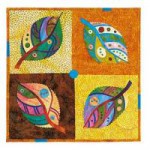 Quilting comes in all different styles and depends on the traditions and history of the country of origin. Simply put, quilting is made up of a “sandwich” of fabrics, the top layer which is the pattern part and can be made up of quilt blocks, the middle which is called the batting (padding) and the back which is usually a complimentary colour to the top pattern.
Quilting comes in all different styles and depends on the traditions and history of the country of origin. Simply put, quilting is made up of a “sandwich” of fabrics, the top layer which is the pattern part and can be made up of quilt blocks, the middle which is called the batting (padding) and the back which is usually a complimentary colour to the top pattern.
I’ve put together a list of the commonly used terms in quilting in this quilting terms definitions article so you have a quick reference guide.
Quilting Terms Definitions
Accent quilts – This is a pattern that follows different lines but works with your patchwork pattern.
Achromatic – Black, white and grey color schemes.
Album quilts – These are quilts made for a specific event and made up of different blocks. These are personal to the recipient or maker of the quilt and are sometimes given as gifts to mark a special occasion.
Amish Quilts – Quilts that are made to be functional and are very simplistic.
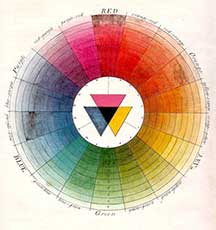
Anchor fabric – Used in machine piecing to hold the fabric together.
Appliqué – This is often used on quilts for decoration. It’s done by sewing smaller pieces of fabric onto the face of the quilt to make a pattern figure or character. You can use decorative stitching for attaching the pieces and create some beautiful effects.
Backing fabric – This is the fabric that goes on the back of the quilt and is usually a complimentary color to the front.
Bargello quilts – These are created with fabric strips to create the look of a wave.
Basting – This is a temporary stitch used to hold the 3 quilt layers together while preparing to sew. There are specially made sticky sprays that you can use as well as stitches and pins.
Batting – This is the padded layer of your quilt sandwich. You can read more about batting here.
Bearding – This is when the fibers from the batting break through to the surface of the front or back of the quilt. It’s more common when using polyester batting.
Betweens – These are quilting needles and they are much shorter than normal sewing needles. The most commonly used sizes are 12, 10 and 9 with the higher number being longer.
Binding – Binding is used for around the quilt edges. You can buy ready-made, called bias binding (cut on the bias), or you can make your own. It’s cut on the bias to prevent pulling the quilt out of shape. Cut on the bias means the fabric is cut diagonally across the grain.
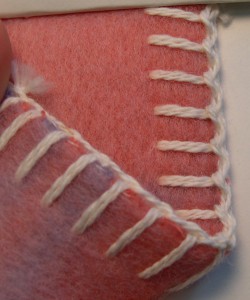 Blanket stitch – Historically, blanket stitch was used to prevent the edges of blankets fraying. It is now used also used for decorative finishes and for attaching applique.
Blanket stitch – Historically, blanket stitch was used to prevent the edges of blankets fraying. It is now used also used for decorative finishes and for attaching applique.
Block – A section of the quilt top, a group of blocks are sewn together to create the quilt top. For a more detailed explanation check out my article here.
Border – these are fabric strips used between blocks to frame patterns. They can also used on the top, bottom and sides.
Cats ears – A style of block, which is also known as Prairie Points.
Chain sewing – This is a fast way of piecing your quilt together by using a continual thread without the need to finish off and restart.
Chain stitch – More commonly used in embroidery this is a series of looped stitches which form a chain.
Charm quilts – The same shape is used throughout, but no fabric is used more than once.
Cheaters Cloth – This is fabric that has a patchwork pattern already printed on it.
Cool colours – Green and blue hues.
Crazy quilt – Irregular pieces of fabric are stitched to the foundation then decorated.
Cross hatch – This is to help with hand stitching, parallel lines are marked on the quilt using diamonds, rectangles and squares.
Dimensional appliqué – Appliques that stand proud of the quilt cover. Sometimes these are lightly stuffed to create the effect.
Echo quilting – A repeat pattern that goes around the edge of a piece or design.
Fat Quarter – Pieces of fabric cut to 18” x 22.”
Foundation blocks – Blocks made up of any amount of small bits of fabric. These are then joined to create the top of the patchwork. It’s important to try and keep the straight of grain on the edge of the block.
Friendship quilt – Friends and family exchange quilts which have been made with swapped fabric and/or with messages sewn in.
Grain – The fiber line which runs perpendicular to the side selvedge.
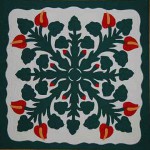 Hawaiian appliqué – Detailed applique applied onto quilt fabric.
Hawaiian appliqué – Detailed applique applied onto quilt fabric.
Hoops – large frames to hold the quilt in place for hand or machine stitching.
Lattice strips – Lattice strips are used to border the blocks.
Meandering/stippling style – This is a quilt stitch where none of the stitching should touch. Once you have stitched a line, you can’t cross over it.
Marking – The quilt gets marked by freehand or tracing to give a stitching guide. Tailors chalk or wax is most commonly used for this.
Medallion quilt – The quilt has a central design and the rest of the pattern follows outwards.
Millenium quilts – These were made to commemorate the year 2000.
Miters – A method used for measuring diagonals and angles.
Monochromatic – All one color.
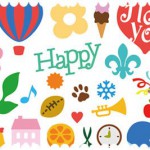 Motif stitching – This can be done on plain or patchwork quilting and is where the quilter incorporates names, animals, flowers etc.
Motif stitching – This can be done on plain or patchwork quilting and is where the quilter incorporates names, animals, flowers etc.
Muslin – Muslin is often used as a foundation fabric as it is very thin and plain.
No knots – Knots should be hidden within the quilt by pulling the knot through to the batting layer. There is a finishing technique where you hide you know in the centre batting. Wrap the cotton twice around the needle, push the needle back through the last stitch hole then pull it through so the knot is hidden in the batting. Cut the thread as close to the fabric as possible.
Off hand – Using the left hand to guide the needle from underneath the quilt.
Outline stitching – Outline stitching is done by sewing a ¼” away from the seam. This provides an outline and also strengthens the quilt.
Paper piecing –This is where you stitch your fabric block with a paper foundation. Once the piece has been sewn, the paper is removed. There is an excellent tutorial on Craftsy explaining this in more detail.
Piecing – Sewing your cut pieces of fabric together to form the blocks or patchwork.
Quilting Thread – Strong cotton which is glazed to help it pass through the layers of quilt.
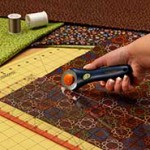 Rotary Cutter – A rotary cutter is a tool used for cutting shapes of fabric, used with a cutting mat and a quilting ruler.
Rotary Cutter – A rotary cutter is a tool used for cutting shapes of fabric, used with a cutting mat and a quilting ruler.
Sampler – A sampler shows many different techniques in one quilt.
Sashing –Fabric strips that separate blocks.
Satin Stich – Stitching done side by side.
Selvedge – The selvedge is is the finished edge of the fabric where the weave was finished off.
Seminole quilting – Large pieces of fabric are created with pieces, then the joined fabric is cut and the shapes repeated. “Seminole” comes from the Native American tribeof the same name. Early on, in the 1800s, it was such a long journey to trade for cloth, the women would use what was left from the cloth bolts. The strips were joined together to make “strip clothing.” The Seminole quilts made now are usually simple designs, but you can see more elaborate quilt patterns.
Sewing in the ditch – Stitches are hardly visible by sewing very close to the seam.
Sharps – Very fine needles used for applique and joining pieces.
Stencils– These are pre-made shapes used for transferring motifs and designs.
Template – These come in a range of shapes and are using for cutting pieces of fabric. They can be made of plastic (quilting ruler), paper or sandpaper.
If you think I’ve missed any important definitions out of this quilting terms glossary, feel free to contact me or leave a comment below.

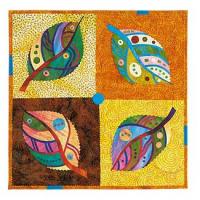
Hi Kathy,
So glad i found your website as my nan has been bugging me for a while now to help find her some information about quilting. As you can imagine i don’t know anything about it myself and my nan is not on the internet so i have been given the task of finding out what she needs to know to get started.
Agains Thank you as your site has just made my life a little easier.
How nice of you to help your Nan Mark, and exciting she wants to do some quilting! I hope you find plenty of useful information and please let me know if she asks any questions that I haven’t covered. 🙂
Hi, Kathy! That is a very complete list you have compiled. I have never heard of the Medallion Quilt. I’ve seen it, but didn’t realize it had a name. I also did not realize that a quilt made for an event or is personal to the recipeint was called an Album Quilt, interesting. Could you explain Seminole quilting again?
“Seminole” comes from the Native Americans of the same name. In the 1800s, because it was such a long journey to trade for cloth, the women would use what was left from the end of the cloth bolts. These were strips that were joined together to make “strip clothing.” The Seminole quilts made now are generally simple designs, but sometimes you see more elaborate quilt patterns.
Thanks for visiting and leaving a comment. 🙂
Wow, that’s very interesting. We have a few areas in the city I live in here in the US that are named after this tribe. Thank you for sharing that.
I’ll update the article to include this information about Seminole quilting, thanks for asking. 🙂
Thanks sharing all the quilting terms definitions. Users knowing these terms will reach new levels of skill and knowledge in this industry. Your site indicates that you give your users first class service and made them your top priority.
Thanks for sharing.
Thanks sharing all the quilting terms definitions. Users knowing these terms will reach new levels of skill and knowledge in this industry. Your site indicates that you give your users first class service and made them your top priority.
Thanks for sharing and keep up the great job!
Thanks Tony, it’s always handy to have a reference guide whatever hobby you choose. I know when I first started quilting I had no idea what a fat quarter was! Thanks for stopping by and leaving a comment. 🙂
Hi Kathy. I can’t think of any quilting terms or definitions that you’ve missed. This is the craft that I would most like to try next. I have a stash of fabrics but most of them are poly cotton not pure cotton. Do you think they would work OK? I would like to start with machine quilting (joining strips) as a first attempt just to see how it works out.
Hi Annie, exciting that you’re going to take up quilting! Polycottons work well in quilting too, you just need a bit more control when sewing as they tend to be a bit slippy. I would probably baste the strips together first for more accuracy when machining. Good luck and let me know how you get on.:)
Hi Kathy,
Wow that’s a lot of definitions there that I am not familiar with. I used to know someone who would be quite into this and she made some nice things. Makes me think of a nice warm blanket on a cold winters day. Glad it’s now spring for me though!
Yes, I know what you mean, nothing a like a cosy handmade quilt to keep you warm! Thanks for stopping by and leaving a comment. 🙂
Wow! I had no idea that there were so many different types of quilts! My husbands grandmother, made him a quilt when he was little and we still have it! I love the look of them. I think if I ever wanted to make a quilt your page would be very helpful to figure out what type I would want to make, and which techniques are best to use. 😀
Awesome Job!
Thank you Elysse. 🙂
When I first started writing this article there were a few types of quilts I’d never heard of, like Seminole. The history behind these quilts is very interesting.
How lovely your husband still has his quilt from grandmother, most get lost with time. If you do decide to start quilting, let me know, I’d love to see how you get on with it. 🙂
hi, i am from Tennesse and my family always quilted back through the years.
It is a lost heritage and art form.
How hard is the learning curve for somone with no skills at sewing?
I do have a sewing machine. Is this an expensive hobby and how long til your producing decent quilts?
Thanks Lisa
HI Lisa
Quilting has made a big comeback recently I’m pleased to say. If you can use a sewing machine then you can make a basic quilt. There are lots of tips and tricks if you start making more elaborate quilts but, in my opinion accuracy of cutting the fabric pieces right at the start is the most important.
It wouldn’t take long for you to be producing works of art! 🙂
What a great quilting website you have, Kathy. I’m delighted to have found you! Quilting has been a tradition in my family for generations. I thought it was going to die out with me, but thanks to you I now have a use for all those pieces of material the groomer puts around my pet’s neck. I can make a doggy quilt for my little Diva’s bed. It can be an heirloom thing. Some of those kerchiefs go way back to other dogs I’ve loved and have crossed “the rainbow bridge.” And I’ll get to clean out a drawer! It’s definitely a win-win situation! Thanks again!
What a great idea Sharon and a wonderful way to remember your pets with an heirloom quilt. Quilting isn’t something my family has done in the past, although it was my 2 Grans who taught me to sew and knit. I have 3 young grandchildren so hopefully 1 of them will take an interest. 🙂
This is a great little write up on Quilting terminology! My mother and grandmother both use to quilt all the time. It was part of their era’s really. Not a very big population of quilters these days though? I tried to get my mother to teach my wife and she started too, but in today’s busy pace of things there just isn’t any time to sit down and do it. I will have to show them all this site as I think they would ever much enjoy it. Thank you for the terms.. Even I learned something new today!
Hi John, you’d be surprised at the amount of quilting enthusiasts there are today. Quilting has seen a HUGE leap in popularity! I think the modern day quilting machines are designed to get around the problem of “not enough time”, you can still be creative, but much of the process is automated. Perhaps if your wife had a computerized sewing machine for quilting you’d get some nice covers for your bed! 🙂